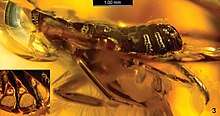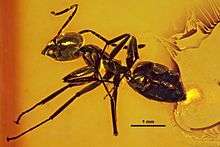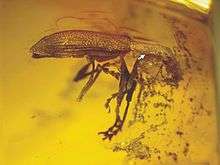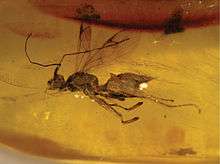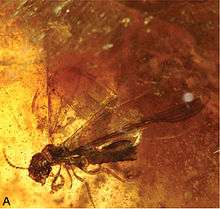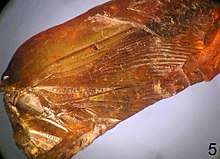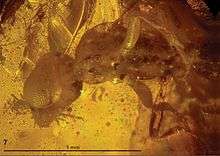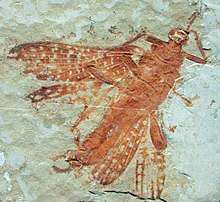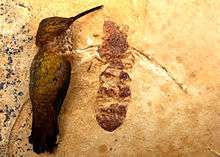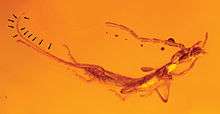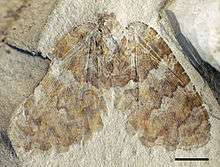2011 in arthropod paleontology
| |||
|---|---|---|---|
This list of fossil arthropods described in 2012 is a list of new taxa of trilobites, fossil insects, crustaceans, arachnids and other fossil arthropods of every kind that have been described during the year 2012. The list only includes taxa at the level of genus or species.
Arachnids
| Name | Novelty | Status | Authors | Age | Unit | Location | Notes | Images |
|---|---|---|---|---|---|---|---|---|
|
Acarus indicus[1] |
Sp. nov |
Disputed |
Kumar et al. |
Early Permian |
Manjir Formation |
A mite. Originally described as a species of Acarus; Sidorchuk (2018) considered it more likely to be a misidentified immature nothrine oribatid mite (probably a member of the family Nothridae), and more likely to be a contaminant from the extant soil fauna rather than a genuine Paleozoic fossil.[2] |
||
|
Ameticos[3] |
Gen. et sp. nov |
Garwood et al. |
Carboniferous (late Stephanian) |
A member of Opiliones. The type species is A. scolos. |
||||
|
Burmesiola[4] |
Gen. et sp. nov |
Valid |
Wunderlich |
A tree trunk spider. Genus includes new species B. cretacea. |
||||
|
Chaerilobuthus[5] |
Gen. et sp. nov |
Valid |
Lourenço & Beigel |
A scorpion. The type species is C. complexus. |
||||
|
Eoscaphiella[4] |
Gen. et sp. nov |
Valid |
Wunderlich |
A member of the family Tetrablemmidae. Genus includes new species E. ohlhoffi. |
||||
|
Episinus tibiaseta[6] |
Sp. nov |
Valid |
Wunderlich |
A member of the family Theridiidae, a species of Episinus. |
||||
|
Femurraptor[6] |
Gen. et sp. nov |
Valid |
Wunderlich |
A member of the family Theridiidae. Genus includes new species F. dominicanus. |
||||
|
Fictotama maculosa[6] |
Sp. nov |
Valid |
Wunderlich |
|||||
|
Glaesacarus[7] |
Gen. et comb. nov |
Valid |
Sidorchuk & Klimov |
Europe (Baltic Sea region) |
A mite; a new genus for "Acarus" rhombeus Koch & Berendt (1854) |
|||
|
Jerseyuloborus[4] |
Gen. et sp. nov |
Valid |
Wunderlich |
A member of the family Uloboridae. Genus includes new species J. longisoma. |
||||
|
Macrogyion[3] |
Gen. et sp. nov |
Garwood et al. |
Carboniferous (late Stephanian) |
A member of Opiliones. The type species is M. cronus. |
||||
|
sp nov |
Selden, Shih & Ren |
largest fossil spider described. |
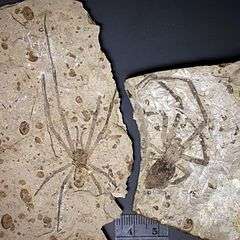 Mongolarachne jurassic | |||||
|
Labidostomma paleoluteum[10] |
Sp. nov |
Valid |
Dunlop & Bertrand |
Europe (Baltic Sea region) |
A mite, a species of Labidostomma. |
|||
|
Praeterleptoneta tibialis[4] |
Sp. nov |
Valid |
Wunderlich |
A member of Araneomorphae belonging to the family Praeterleptonetidae. Originally described as a species of Praeterleptoneta, subsequently transferred to the separate genus Parvispina.[11] |
||||
|
Scopoides dominicanus[6] |
Sp. nov |
Valid |
Wunderlich |
A ground spider, a species of Scopoides. |
||||
|
Siro balticus[12] |
Sp. nov |
Valid |
Dunlop & Mitov |
Europe (Baltic Sea region) |
||||
|
Spinocharinus[13] |
Gen. et sp. nov |
Valid |
Poschmann & Dunlop |
Early Devonian |
A member of Trigonotarbida. The type species is S. steinmeyeri. |
|||
Crustaceans
| Name | Novelty | Status | Authors | Age | Unit | Location | Notes | Images |
|---|---|---|---|---|---|---|---|---|
|
Dynamenella miettoi[14] |
Sp. nov |
Valid |
De Angeli & Lovato |
Eocene (Lutetian) |
An isopod belonging to the family Sphaeromatidae. |
|||
Insects
| Name | Novelty | Status | Authors | Age | Unit | Location | Notes | Images |
|---|---|---|---|---|---|---|---|---|
|
sp nov |
valid |
first snakefly from the Green River Formation |
||||||
|
Gen et sp nov |
Valid |
Emeljanov & Shcherbakov |
A planthopper, type species A. rasnitsyni |
| ||||
|
Comb nov |
valid |
(Mayr) |
Fossil Dolichoderin ant |
| ||||
|
Aradus andancensis[18] |
Sp nov |
valid |
Marchal, Guilbert, |
Montagne d'Andance |
A flat bug |
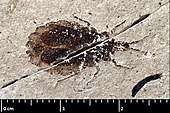 Aradus andancensis | ||
|
Gen et sp nov |
valid |
Yunakov & Kirejtshuk |
Monotypic broad-nosed weevil genus, one species A. groehni |
| ||||
|
Subfam, Gen et sp nov |
valid |
Monotypic earwig subfamily, one species A. ethirosomatia |
| |||||
|
sp nov |
valid |
Mey |
the second species in Baltimartyria |
| ||||
|
sp nov |
Valid |
Guglielmino & Olmi |
A dryinid wasp. |
| ||||
|
sp nov |
valid |
Chatzimanolis & Engel |
first valid Staphylininae species from the fossil record |
| ||||
|
sp nov |
valid |
Olmi & Guglielmino |
second fossil Dryinus lamellatus group species |
| ||||
|
sp nov |
valid |
Jepsen, Ansorge, & Jarzembowski |
A mesoraphidiid snakefly, one species Iberoraphidia dividua |
|||||
|
sp nov |
valid |
Bechly & Wolf-Schwenninger |
Upper Neocomian |
A mesoraphidiid snakefly, one species Lebanoraphidia nana |
||||
|
sp. |
Valid |
Shi, Liu, & Ren |
Middle Jurassic |
|||||
|
sp. |
Valid |
Liu, Shi, & Ren |
Middle Jurassic |
the smallest species known in the family Grammolingiidae |
||||
|
sp. |
Valid |
Shi, Yang, & Ren |
Middle Jurassic |
|||||
| Mickoleitia longimanus[29] |
ord., fam., gen. et sp. |
valid |
Staniczek, Bechly, & Godunko |
Lower Cretaceous |
A new genus in the new family Mickoleitiidae and a new insect order Coxoplectoptera. |
| ||
|
gen et sp nov |
valid |
Huber |
oldest mymarid described |
| ||||
|
Gen et sp. nov |
valid |
Cambay amber |
A Termitid termite |
| ||||
|
gen et sp. |
valid |
Szwedo |
Oise amber |
Second fossil lophopid planthopper from Europe |
| |||
|
Sp. nov |
valid |
Cambay amber |
A Stylotermitid termite |
| ||||
|
Platyperla marquati[33] |
Species |
Valid |
Gallego et al. |
Late Triassic |
Potrerillos Formation |
A platyperlid stonefly, a species of Platyperla. |
||
|
fam, gen et sp. |
valid |
Brothers |
sister genus to Plumariidae |
| ||||
|
sp nov |
valid |
Dlussky & Radchenko |
Scandinavian amber |
A fossil ant |
||||
|
Gen et sp. nov |
valid |
Cambay amber |
A Stylotermitid termite |
| ||||
|
Gen. et sp. |
Valid |
Nel & Delfosse |
| |||||
|
Sp nov |
valid |
Poinar |
A termitaphidid termite bug |
|||||
| Titanomyrma lubei[37] |
Gen. et sp. |
valid |
Archibald, Johnson, |
Green River Formation USA |
new genus for the largest known ants |
| ||
|
Gen et sp. nov |
Valid |
Oldest member of the family Diplatyidae |
| |||||
|
Gen et sp. nov |
Valid |
Peng, Makarkin, Wang, & Ren |
A psychopsid silky lacewing, only species U. alexi |
| ||||
|
Gen et sp. nov |
valid |
Engel & Singh |
Cambay amber |
A Rhinotermitid termite |
| |||
Trilobites
| Name | Novelty | Status | Authors | Age | Unit | Location | Notes | Images |
|---|---|---|---|---|---|---|---|---|
|
Chasbellus[39] |
Gen. et 2 sp. nov |
Valid |
Loch & Taylor |
Early Ordovician |
Bliss Formation |
A member of Asaphida belonging to the family Symphysurinidae. The type species is C. milleri; genus also includes C. repetskii. |
||
|
Gladiatoria crowei[40] |
Sp. nov |
Valid |
Adrain, McAdams & Westrop |
A member of the family Bathyuridae. |
||||
|
Gladiatoria harrisi[40] |
Sp. nov |
Valid |
Adrain, McAdams & Westrop |
A member of the family Bathyuridae. |
||||
|
Gladiatoria nielsenae[40] |
Sp. nov |
Valid |
Adrain, McAdams & Westrop |
A member of the family Bathyuridae. |
||||
|
Gladiatoria phoenixi[40] |
Sp. nov |
Valid |
Adrain, McAdams & Westrop |
A member of the family Bathyuridae. |
||||
|
Gladiatoria reedi[40] |
Sp. nov |
Valid |
Adrain, McAdams & Westrop |
A member of the family Bathyuridae. |
||||
|
Hebediscus williamsi[41] |
Sp. nov |
Valid |
Westrop & Landing |
Early Cambrian |
A member of the family Hebediscidae. |
|||
|
Sp. nov |
Valid |
McAdams & Adrain |
A member of the family Pliomeridae. |
|||||
|
Luhops coquus[43] |
Sp. nov |
Valid |
Rushton |
Abbey Shale |
||||
|
Panisaspis[44] |
Gen. et 6 sp. et comb. nov |
Valid |
McAdams & Adrain |
Early Ordovician |
Fillmore Limestone |
A member of the family Pliomeridae. The type species is P. millardensis; genus also includes new species P. deltaensis, P. loganensis, P. rancherensis, P. sevierensis and P. topscityensis, as well as "Protopliomerops" quattuor Hintze (1953). |
||
|
Sp. nov |
Valid |
McAdams & Adrain |
A member of the family Pliomeridae. |
|||||
|
Sp. nov |
Valid |
McAdams & Adrain |
Fillmore Limestone |
A member of the family Pliomeridae. |
||||
|
Sp. nov |
Valid |
McAdams & Adrain |
Fillmore Limestone |
A member of the family Pliomeridae. |
||||
|
Sp. nov |
Valid |
McAdams & Adrain |
A member of the family Pliomeridae. |
|||||
|
Sp. nov |
Valid |
McAdams & Adrain |
A member of the family Pliomeridae. |
|||||
|
Psalikilopsis newmani[46] |
Sp. nov |
Valid |
Adrain et al. |
A member of the family Bathyuridae. |
||||
|
Psalikilopsis paracuspidicauda[46] |
Sp. nov |
Valid |
Adrain et al. |
A member of the family Bathyuridae. |
||||
|
Psalikilopsis redfordi[46] |
Sp. nov |
Valid |
Adrain et al. |
A member of the family Bathyuridae. |
||||
|
Symphysurina ethingtoni[39] |
Sp. nov |
Valid |
Loch & Taylor |
Late Cambrian and Early Ordovician |
A member of Asaphida belonging to the family Symphysurinidae. |
|||
|
Symphysurina straatmannae[39] |
Sp. nov |
Valid |
Loch & Taylor |
Late Cambrian and Early Ordovician |
Bliss Formation |
A member of Asaphida belonging to the family Symphysurinidae. |
||
References
- ↑ Prabhat Kumar; Neerja Jha; D.D. Bhattacharya; A.C. Pande (2011). "Acarid mites from Early Permian sediments of the Chamba valley, Himachal Pradesh, India" (PDF). Journal of the Palaeontological Society of India. 56 (2): 171–179.
- ↑ Ekaterina A. Sidorchuk (2018). "Mites as fossils: forever small?". International Journal of Acarology. in press. doi:10.1080/01647954.2018.1497085.
- 1 2 Russell J. Garwood; Jason A. Dunlop; Gonzalo Giribet; Mark D. Sutton (2011). "Anatomically modern Carboniferous harvestmen demonstrate early cladogenesis and stasis in Opiliones". Nature Communications. 2: Article number 444. doi:10.1038/ncomms1458. PMID 21863011.
- 1 2 3 4 Jörg Wunderlich (2011). "Some fossil spiders (Araneae) in Cretaceous ambers". In Jörg Wunderlich. Beiträge zur Araneologie, 6. pp. 539–557.
- ↑ Wilson R. Lourenço; Alex Beigel (2011). "A new scorpion fossil from the Cretaceous amber of Myanmar (Burma). New phylogenetic implications". Comptes Rendus Palevol. 10 (8): 635–639. doi:10.1016/j.crpv.2011.08.001.
- 1 2 3 4 Jörg Wunderlich (2011). "Some fossil spiders in Dominican amber (Araneae: Hersiliidae, Theridiidae, Gnaphosidae)". In Jörg Wunderlich. Beiträge zur Araneologie, 6. pp. 461–471.
- ↑ Ekaterina A. Sidorchuk; Pavel B. Klimov (2011). "Redescription of the mite Glaesacarus rhombeus (Koch & Berendt, 1854) from Baltic amber (Upper Eocene): evidence for female-controlled mating". Journal of Systematic Palaeontology. 9 (2): 183–196. doi:10.1080/14772019.2011.566585.
- ↑ Selden, P. A.; Shih, C.K.; Ren, D. (2011). "A golden orb-weaver spider (Araneae: Nephilidae: Nephila) from the Middle Jurassic of China". Biology Letters. 7 (5): 775–8. doi:10.1098/rsbl.2011.0228. PMC 3169061. PMID 21508021.
- 1 2 Selden, P. A.; Shih, C.K.; Ren, D. (2013). "A giant spider from the Jurassic of China reveals greater diversity of the orbicularian stem group". Naturwissenschaften. 100: 1171–1181. Bibcode:2013NW....100.1171S. doi:10.1007/s00114-013-1121-7. PMC 3889289.
- ↑ Jason A. Dunlop; Michel Bertrand (2011). "Fossil labidostomatid mites (Prostigmata: Labidostommatidae) from Baltic amber". Acarologia. 51 (2): 191–198. doi:10.1051/acarologia/20112006.
- ↑ Jörg Wunderlich (2015). "On the evolution and the classification of spiders, the Mesozoic spider faunas, and descriptions of new Cretaceous taxa mainly in amber from Myanmar (Burma) (Arachnida: Araneae)". In Jörg Wunderlich. Beiträge zur Araneologie, 9: Mesozoic spiders and other fossil arachnids. pp. 21–408.
- ↑ Jason A. Dunlop; Plamen G. Mitov (2011). "The first fossil cyphophthalmid harvestman from Baltic amber" (PDF). Arachnologische Mitteilungen. 40: 47–54.
- ↑ Markus Poschmann; Jason A. Dunlop (2011). "Trigonotarbid arachnids from the Lower Devonian (Siegenian) of Bürdenbach (Lahrbach Valley, Westerwald area, Rhenish Slate Mountains, Germany)". Paläontologische Zeitschrift. 85 (4): 433–447. doi:10.1007/s12542-011-0109-x.
- ↑ Antonio De Angeli; Alessandro Lovato (2011). "Dynamenella miettoi n. sp., nuovo isopode (Crustacea, Flabellifera, Sphaeromatidae) dell'Eocene del Veneto (Vicenza, Italia settentrionale)" (PDF). Lavori – Società Veneziana di Scienze Naturali. 36: 111–118.
- ↑ Engel, Michael S. (2011). "A new snakefly from the Eocene Green River Formation (Raphidioptera: Raphidiidae)". Transactions of the Kansas Academy of Science. 114 (1–2): 77–87. doi:10.1660/062.114.0107.
- ↑ Emeljanov, A. F.; Shcherbakov, D. E. (2011). "A new genus and species of Dictyopharidae (Homoptera) from Rovno and Baltic amber based on nymphs". ZooKeys. 130: 175–184. doi:10.3897/zookeys.130.1775.
- ↑ Heterick, B. E.; Shattuck, S. (2011). "Revision of the ant genus Iridomyrmex (Hymenoptera: Formicidae)". Zootaxa. 2845: 169.
- ↑ Marchal, L.; Guilbert, E.; Brisac, P.; Nel., A. (2011). "A new record and a new species of Aradidae fossils (Hemiptera: Heteroptera)". Zootaxa. 2832: 56–62.
- ↑ Yunakov, N.N.; Kirejtshuk, A.G. (2011). "New genus and species of broad-nosed weevils from Baltic amber and notes on fossils of the subfamily Entiminae (Coleoptera, Curculionidae)". ZooKeys. 160: 73–96. doi:10.3897/zookeys.160.2108. PMC 3253632. PMID 22303121.
- 1 2 Engel, M.S. (2011). "New earwigs in mid-Cretaceous amber from Myanmar (Dermaptera, Neodermaptera)". ZooKeys. 130: 137–152. doi:10.3897/zookeys.130.1293. PMC 3260755. PMID 22259272.
- ↑ Mey, Wolfram (2011). "On the systematic position of Baltimartyria Skalski, 1995 and description of a new species from Baltic amber (Lepidoptera, Micropterigidae)". ZooKeys. 130: 331–342. doi:10.3897/zookeys.130.1480. PMC 3260770. PMID 22259287.
- ↑ Guglielmino, A.; Olmi, M. (2011). "Revision of fossil species of Deinodryinus, with description of a new species (Hymenoptera, Dryinidae)". ZooKeys. 130: 495–504. doi:10.3897/zookeys.130.1326. PMC 3260777. PMID 22259295.
- ↑ Chatzimanolis, S.; Engel, M. S. (2011). "A new species of Diochus from Baltic amber (Coleoptera, Staphylinidae, Diochini)" (PDF). ZooKeys. 138: 65–73. doi:10.3897/zookeys.138.1896. PMC 3208521. PMID 22144854.
- ↑ Olmi, Massimo; Guglielmino, Adalgisa (2011). "Revision of fossil species of Dryinus belonging to lamellatus group, with description of a new species (Hymenoptera, Dryinidae)" (PDF). 130: 505–514. doi:10.3897/zookeys.130.133.
- ↑ Jepson, J.E.; Ansorge, J.; Jarzembowski, E.A. (2011). "New snakeflies (Insecta: Raphidioptera) from the Lower Cretaceous of the UK, Spain and Brazil". Palaeontology. 54 (2): 385–395. doi:10.1111/j.1475-4983.2011.01038.x.
- ↑ Bechly, G.; Wolf-Schwenninger, K. (2011). "A new fossil genus and species of snakefly (Raphidioptera: Mesoraphidiidae) from Lower Cretaceous Lebanese amber, with a discussion of snakefly phylogeny and fossil history" (PDF). Insect Systematics and Evolution. 42 (2): 221–236. doi:10.1163/187631211X568164.
- 1 2 Shi, C.; Yang, Q.; Ren, D. (2011). "Two new fossil lacewing species from the Middle Jurassic of Inner Mongolia, China (Neuroptera: Grammolingiidae)" (PDF). Acta Geologica Sinica. 85: 482–489. doi:10.1111/j.1755-6724.2011.00416.x. Archived from the original (PDF) on 2012-03-24.
- ↑ Liu, Y.; Shi, C.; Ren, D. (2011). "A new lacewing (Insecta: Neuroptera: Grammolingiidae) from the Middle Jurassic of Inner Mongolia, China" (PDF). Zootaxa. 2897: 51–56.
- ↑ Staniczek, A.H.; Bechly, G.; Godunko, R.J. (2011). "Coxoplectoptera, a new fossil order of Palaeoptera (Arthropoda: Insecta), with comments on the phylogeny of the stem group of mayflies (Ephemeroptera)" (PDF). Insect Systematics & Evolution. 42 (2): 101–138. doi:10.1163/187631211X578406.
- 1 2 Poinar, G.; Huber, J. T. (2011). "A new genus of fossil Mymaridae (Hymenoptera) from Cretaceous amber and key to Cretaceous mymarid genera". ZooKeys. 130: 461–472. doi:10.3897/zookeys.130.1241. PMC 3260775. PMID 22259293.
- 1 2 3 4 Engel, M.S.; Grimaldi, D.A.; Nascimbene, P.C.; Singh, H. (2011). "The termites of Early Eocene Cambay amber, with the earliest record of the Termitidae (Isoptera)". ZooKeys. 148: 105–123. doi:10.3897/zookeys.148.1797. PMC 3264413. PMID 22287892.
- ↑ Szwedo, J. (2011). "Ordralfabetix sirophatanis gen. et sp. n.—the first Lophopidae from the Lowermost Eocene Oise amber, Paris Basin, France (Hemiptera: Fulgoromorpha)" (PDF). Zootaxa. 2822: 52–60.
- ↑ Gallego, O.F.; Rébori, L; Zavattieri, A.M.; Sinitshenkova, N.; Lara, M.B. ,; Martins-Neto, R.G. (2011). "The most ancient Platyperlidae (Insecta, Perlida= Plecoptera) from early Late Triassic deposits in southern South America". Ameghiniana. 48 (4): 447–461. doi:10.5710/amgh.v48i4(360).
- ↑ Brothers, Denis J. (2011). "A new Late Cretaceous family of Hymenoptera, and phylogeny of the Plumariidae and Chrysidoidea (Aculeata)" (PDF). ZooKeys. 130: 515–542. doi:10.3897/zookeys.130.1591. PMC 3260779. PMID 22259297.
- ↑ Dlussky, G. M.; Radchenko, A. G. (2011). "Pristomyrmex rasnitsyni sp. n., the first known fossil species of the ant genus Pristomyrmex Mayr (Hymenoptera: Formicidae) from the Late Eocene Danish amber". Russian Entomological Journal. 20 (3): 251–254.
- ↑ Nel, A.; Delfosse, E. (2011). "A new Chinese Mesozoic stick insect". Acta Palaeontologica Polonica. 56 (2): 429–432. doi:10.4202/app.2009.1108.
- ↑ Archibald, S. Bruce; Johnson, Kirk R.; Mathewes, Rolf W.; Greenwood, David R. (2011). "Intercontinental dispersal of giant thermophilic ants across the Arctic during early Eocene hyperthermals". Proceedings of the Royal Society B. 278 (1725): 3679–3686. doi:10.1098/rspb.2011.0729. PMC 3203508. PMID 21543354.
- ↑ Peng, Y.; Makarkin, V.N.; Wang, X.; Ren, D. (2011). "A new fossil silky lacewing genus (Neuroptera, Psychopsidae) from the Early Cretaceous Yixian Formation of China". ZooKeys. 130: 217–228. doi:10.3897/zookeys.130.1576. PMC 3260761. PMID 22259278.
- 1 2 3 James D. Loch; John F. Taylor (2011). "New symphysurinid trilobites from the Cambrian-Ordovician boundary interval in the western United States". Memoirs of the Association of Australasian Palaeontologists. 42: 417–436.
- 1 2 3 4 5 Jonathan M. Adrain; Neo E.B. McAdams; Stephen R. Westrop (2011). "Affinities of the Lower Ordovician (Tulean; lower Floian) trilobite Gladiatoria, with species from the Great Basin, western United States" (PDF). Memoirs of the Association of Australasian Palaeontologists. 42: 321–367.
- ↑ Stephen R. Westrop; Ed Landing (2011). "Lower Cambrian (Branchian) eodiscoid trilobites from the lower Brigus formation, Avalon Peninsula, Newfoundland, Canada". Memoirs of the Association of Australasian Palaeontologists. 42: 209–262.
- ↑ Neo E.B. McAdams; Jonathan M. Adrain (2011). "Systematics of the Lower Ordovician pliomerid trilobite Hintzeia, with species from the Great Basin, western USA" (PDF). Zootaxa. 2910: 1–45.
- ↑ Adrian W.A. Rushton (2011). "The mid-Cambrian (Drumian) centropleurid trilobite Luhops and its relatives from the Abbey Shale formation near Nuneaton, central England". Memoirs of the Association of Australasian Palaeontologists. 42: 93–104.
- ↑ Neo E.B. McAdams; Jonathan M. Adrain (2011). "Panisaspis, a new genus of pliomerid trilobites from the Lower Ordovician (Ibexian; Tulean and Blackhillsian) of the Great Basin, western USA" (PDF). Zootaxa. 2969: 1–68.
- 1 2 3 4 5 Neo E.B. McAdams; Jonathan M. Adrain (2011). "Revision of the Lower Ordovician (lower Floian; Tulean) pliomerid trilobite Protopliomerella, with new species from the Great Basin, western USA" (PDF). Zootaxa. 3144: 1–113.
- 1 2 3 Jonathan M. Adrain; Neo E.B. McAdams; Stephen R. Westrop; Talia S. Karim (2011). "Systematics and affinity of the Lower Ordovician (Tulean; lower Floian) trilobite Psalikilopsis" (PDF). Memoirs of the Association of Australasian Palaeontologists. 42: 369–416.
